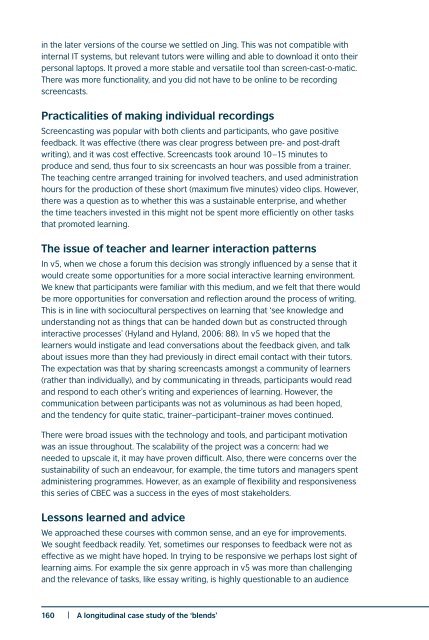Blended Learning in English Language Teaching: Course Design and Implementation
Blended Learning in English Language Teaching: Course Design and Implementation
Blended Learning in English Language Teaching: Course Design and Implementation
You also want an ePaper? Increase the reach of your titles
YUMPU automatically turns print PDFs into web optimized ePapers that Google loves.
<strong>in</strong> the later versions of the course we settled on J<strong>in</strong>g. This was not compatible with<br />
<strong>in</strong>ternal IT systems, but relevant tutors were will<strong>in</strong>g <strong>and</strong> able to download it onto their<br />
personal laptops. It proved a more stable <strong>and</strong> versatile tool than screen-cast-o-matic.<br />
There was more functionality, <strong>and</strong> you did not have to be onl<strong>in</strong>e to be record<strong>in</strong>g<br />
screencasts.<br />
Practicalities of mak<strong>in</strong>g <strong>in</strong>dividual record<strong>in</strong>gs<br />
Screencast<strong>in</strong>g was popular with both clients <strong>and</strong> participants, who gave positive<br />
feedback. It was effective (there was clear progress between pre- <strong>and</strong> post-draft<br />
writ<strong>in</strong>g), <strong>and</strong> it was cost effective. Screencasts took around 10 –15 m<strong>in</strong>utes to<br />
produce <strong>and</strong> send, thus four to six screencasts an hour was possible from a tra<strong>in</strong>er.<br />
The teach<strong>in</strong>g centre arranged tra<strong>in</strong><strong>in</strong>g for <strong>in</strong>volved teachers, <strong>and</strong> used adm<strong>in</strong>istration<br />
hours for the production of these short (maximum five m<strong>in</strong>utes) video clips. However,<br />
there was a question as to whether this was a susta<strong>in</strong>able enterprise, <strong>and</strong> whether<br />
the time teachers <strong>in</strong>vested <strong>in</strong> this might not be spent more efficiently on other tasks<br />
that promoted learn<strong>in</strong>g.<br />
The issue of teacher <strong>and</strong> learner <strong>in</strong>teraction patterns<br />
In v5, when we chose a forum this decision was strongly <strong>in</strong>fluenced by a sense that it<br />
would create some opportunities for a more social <strong>in</strong>teractive learn<strong>in</strong>g environment.<br />
We knew that participants were familiar with this medium, <strong>and</strong> we felt that there would<br />
be more opportunities for conversation <strong>and</strong> reflection around the process of writ<strong>in</strong>g.<br />
This is <strong>in</strong> l<strong>in</strong>e with sociocultural perspectives on learn<strong>in</strong>g that ‘see knowledge <strong>and</strong><br />
underst<strong>and</strong><strong>in</strong>g not as th<strong>in</strong>gs that can be h<strong>and</strong>ed down but as constructed through<br />
<strong>in</strong>teractive processes’ (Hyl<strong>and</strong> <strong>and</strong> Hyl<strong>and</strong>, 2006: 88). In v5 we hoped that the<br />
learners would <strong>in</strong>stigate <strong>and</strong> lead conversations about the feedback given, <strong>and</strong> talk<br />
about issues more than they had previously <strong>in</strong> direct email contact with their tutors.<br />
The expectation was that by shar<strong>in</strong>g screencasts amongst a community of learners<br />
(rather than <strong>in</strong>dividually), <strong>and</strong> by communicat<strong>in</strong>g <strong>in</strong> threads, participants would read<br />
<strong>and</strong> respond to each other’s writ<strong>in</strong>g <strong>and</strong> experiences of learn<strong>in</strong>g. However, the<br />
communication between participants was not as volum<strong>in</strong>ous as had been hoped,<br />
<strong>and</strong> the tendency for quite static, tra<strong>in</strong>er–participant–tra<strong>in</strong>er moves cont<strong>in</strong>ued.<br />
There were broad issues with the technology <strong>and</strong> tools, <strong>and</strong> participant motivation<br />
was an issue throughout. The scalability of the project was a concern: had we<br />
needed to upscale it, it may have proven difficult. Also, there were concerns over the<br />
susta<strong>in</strong>ability of such an endeavour, for example, the time tutors <strong>and</strong> managers spent<br />
adm<strong>in</strong>ister<strong>in</strong>g programmes. However, as an example of flexibility <strong>and</strong> responsiveness<br />
this series of CBEC was a success <strong>in</strong> the eyes of most stakeholders.<br />
Lessons learned <strong>and</strong> advice<br />
We approached these courses with common sense, <strong>and</strong> an eye for improvements.<br />
We sought feedback readily. Yet, sometimes our responses to feedback were not as<br />
effective as we might have hoped. In try<strong>in</strong>g to be responsive we perhaps lost sight of<br />
learn<strong>in</strong>g aims. For example the six genre approach <strong>in</strong> v5 was more than challeng<strong>in</strong>g<br />
<strong>and</strong> the relevance of tasks, like essay writ<strong>in</strong>g, is highly questionable to an audience<br />
160 | A longitud<strong>in</strong>al case study of the ‘blends’


